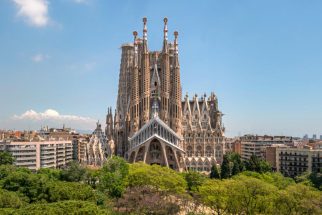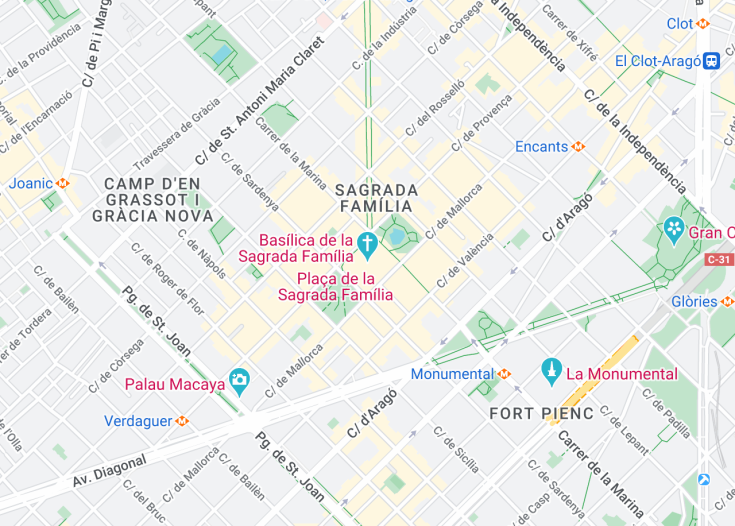The Basílica i Temple Expiatori de la Sagrada Família also known as the Sagrada Família, is a large unfinished minor basilica. It is Antoni Gaudí‘s most famous creation. It is listed as UNESCO World Heritage site.
It takes about 2 hours to visit the Sagrada Família including the towers, the small museum in the basement and the shop. Once inside the basilica, you can stay as long as you want.
Time slots for entry are carefully regulated, so be punctual. There is no guarantee you will be allowed to enter if you are late. Like many places of worship, the Sagrada Familía has a dress code. Avoid wearing sleeveless shirts or shorts and skirts cut above the knee. If you are visiting in summer, consider bringing a light scarf to cover your shoulders.
Sagrada Familia: A masterpiece of design
The Sagrada Familia is a colossal basilica in Barcelona, Spain, and one of the most astonishing testimonials to both Roman Catholic faith and architectural ingenuity. Designed by the renowned architect Antoni Gaudí, this unfinished masterpiece draws over 4.5 million visitors each year, making it one of the most visited monuments in Spain. Although construction commenced in 1882, the church is anticipated to be completed by 2026, the centenary of Gaudí’s death. The basilica is renowned for its soaring towers, intricate facades, and the extensive use of geometrical and natural forms in its design. These elements not only showcase Gaudí’s unique approach to the Modernista movement but also his ability to integrate environment, religion, and architecture into one cohesive and mesmerizing experience. Visiting the Sagrada Familia offers an insight into a profound narrative of devotion and an opportunity to witness a living piece of art evolving with time.
Exploring the unique aspects of Sagrada Familia
The interior of the Sagrada Familia is as impressive as its exterior. The central nave soars skywards with tree-like pillars and branches that support a massive, star-studded roof. This design not only provides structural stability but also creates a meditative forest-like atmosphere, playing with light and shadows to illustrate scenes from the Bible. Visitors can also access the towers, offering breathtaking views over Barcelona and a closer look at the elaborate stonework. Each facade of the basilica tells a different biblical story, capturing moments from the Birth, Passion, and Glory of Christ. Guided tours are available, providing insights into the symbols and narratives embedded in the architecture.
Notable gallery: The Passion Facade
The Passion Facade is one of the most striking aspects of the Sagrada Familia. Designed to depict the suffering and death of Jesus, it contrasts sharply with the elaborate and joyous Nativity Facade. Created by sculptor Josep Maria Subirachs, the facade utilizes sparse, angular figures and minimal ornamentation to evoke a somber mood. This design choice reflects the stark reality of Christ’s last days and stimulates deep reflection among its viewers, making it a powerful and moving part of any visit to the basilica. Observing this facade gives visitors a deeper appreciation of Gaudi’s intent to evoke a strong emotional and spiritual response through architectural forms.
Explore the wonders of the sagrada familia
The Sagrada Familia is a mesmerizing architectural masterpiece designed by Antoni Gaudí, which appeals to visitors of all ages. Whether you are a history enthusiast, a lover of architecture, or someone looking for a unique cultural experience, the Sagrada Familia is a destination that caters to everyone. Visitors can expect a journey through breathtaking interiors and rich histories that reveal the complexities and beauties of both the structure itself and its symbolic significances.
Discover the best season to visit sagrada familia
Visiting the Sagrada Familia during the late spring or early autumn is ideal, as the weather in Barcelona is more temperate. Tourist crowds are generally smaller, enhancing the quality of your visit with a more relaxed atmosphere. Additionally, attending the annual Fiesta de La Mercè in September can provide a unique cultural experience alongside your visit.
Fiesta de la Mercè
This grand city festival features live music, traditional dances, and special tours throughout Barcelona, including areas around Sagrada Familia.
Learn about accessibility and limitations
Understanding the accessibility and limitations at the Sagrada Familia ensures all visitors have a pleasant experience.
Accessibility
Limitations
- Dress code: Modest dress is required for entry.
- Age restrictions: None, but children under 12 should be accompanied by an adult.
- Camera usage: Non-commercial photography without flash is allowed. Tripods are prohibited.
Notes to visitors
- Be prepared for a good deal of walking.
- Consider a guided tour to fully appreciate the historical context.
General information
Useful details to enhance your visit to Sagrada Familia.
Location
Conveniently nestled in the heart of Barcelona, the Sagrada Familia is surrounded by vibrant cafés and shops.
Address: Calle Mallorca, 401, 08013 Barcelona, Spain
Opening hours
Monday to Sunday: 9:00 AM – 8:00 PM Public Holidays: Closed on December 25th and January 1st
Reaching the architectural masterpiece
Car
Accessible by major roads and highways, parking is available in nearby lots. Consider carpooling or renting an eco-friendly vehicle to preserve the area around this iconic site.
Public Transport
From Plaça Catalunya: 20 minutes by metro (Line 2) From Barcelona Sants Station: 15 minutes by metro (Line 5)
Nearby Attractions
Enhance your visit by exploring nearby attractions.
- Barcelona Cathedral – 2.5 km (1.5 miles)
- Picasso Museum – 2.8 km (1.7 miles)
- Parc Guell – 2 km (1.2 miles)
- Barceloneta Beach – 4.5 km (2.8 miles)
- Las Ramblas – 3 km (1.9 miles)
- Magic Fountain of Montjuic – 5 km (3.1 miles)
- FC Barcelona Museum – 6 km (3.7 miles)
- Montjuïc Castle – 6 km (3.7 miles)
- La Boqueria Market – 2.6 km (1.6 miles)
- Arc de Triomf – 1.4 km (0.9 miles)
- Palau de la Musica Catalana – 2.4 km (1.5 miles)
- Poble Espanyol – 4.3 km (2.7 miles)
Common questions
What architectural style is the Sagrada Familia?
How long has the construction of the Sagrada Familia been ongoing?
What is the significance of the facade designs on the Sagrada Familia?
Can visitors access the towers of the Sagrada Familia?
Are there specific guidelines or dress codes for entering the Sagrada Familia?
What are the unique structural or design elements of the Sagrada Familia?
Is photography allowed inside the Sagrada Familia?
What is the best time of year to visit the Sagrada Familia?
Are there any lesser-known facts about the Sagrada Familia?
What can visitors learn about Antoni Gaudí at the Sagrada Familia?
How does the Sagrada Familia contribute to the local community and culture?
Are there future plans for the Sagrada Familia once completed?

Is the Sagrada Familia in Barcelona worth visiting?
Barcelona’s Sagrada Familia is undoubtedly a masterpiece of architectural innovation and a remarkable symbol of Catalan culture. However, it’s essential to consider the immense popularity of this site which often leads to overcrowding. Visitors may find the experience less enjoyable due to long waiting lines and the overwhelming number of tourists. Moreover, while the church’s intricate facades and interiors are breathtaking, the admission fee and the commercial feel might detract from the overall experience. For those seeking a quieter yet equally enriching cultural experience, other nearby locations such as the Gothic Quarter or Parc Guell might offer more pleasant alternatives. Therefore, while the Sagrada Familia is impressive, its value as a tourist destination might vary based on personal preferences towards crowd and commercialization.










